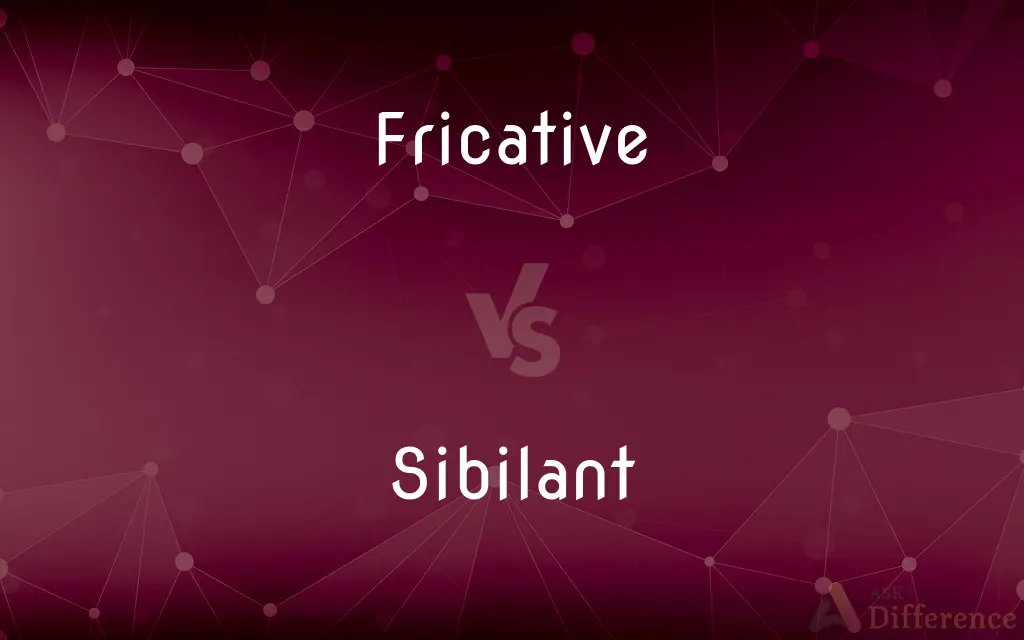Fricative vs. Sibilant — What's the Difference?
Edited by Tayyaba Rehman — By Urooj Arif — Updated on March 25, 2024
Fricatives are consonants made by air flowing through a narrow constriction, while sibilants are a specific type of fricative with a high-pitched, hissing sound.

Difference Between Fricative and Sibilant
Table of Contents
ADVERTISEMENT
Key Differences
Fricatives are a broad category of consonant sounds produced by forcing air through a narrow constriction in the vocal tract, creating turbulent airflow. Sibilants, on the other hand, are a subset of fricatives characterized by a pronounced hissing sound, resulting from high-frequency vibrations.
The production of fricative sounds involves various points of articulation in the mouth, such as the lips (for /f/ and /v/ sounds), teeth (for /θ/ as in "thing" and /ð/ as in "this"), and back of the tongue (for /ʃ/ as in "shoe" and /ʒ/ as in "measure"). Sibilants specifically involve the tongue and roof of the mouth, producing sharper, more resonant sounds.
Fricatives can be voiced or voiceless, depending on whether the vocal cords vibrate during the sound's production. For instance, /f/ is voiceless, and /v/ is its voiced counterpart. Sibilants include both voiced and voiceless sounds, such as the voiceless /s/ and voiced /z/.
In phonetics, the distinction between fricatives and sibilants is significant because sibilants are generally more perceptible due to their higher amplitude and frequency. This makes them more prominent in speech patterns and acoustic signatures.
While all sibilants are fricatives, not all fricatives are sibilants. This distinction is crucial in linguistic studies, phonetic transcription, and language learning, as it affects pronunciation, acoustic characteristics, and linguistic patterns across languages.
ADVERTISEMENT
Comparison Chart
Definition
Consonants made by forcing air through a narrow constriction.
A subset of fricatives with a high-pitched, hissing sound.
Articulation
Various points in the mouth, including lips, teeth, and back of tongue.
Primarily involving the tongue and roof of the mouth.
Examples
/f/, /v/, /θ/ (thing), /ð/ (this)
/s/, /z/, /ʃ/ (shoe), /ʒ/ (measure)
Voicing
Can be voiced or voiceless.
Includes both voiced and voiceless sounds.
Acoustic Features
Characterized by turbulent airflow.
Higher amplitude and frequency, resulting in a pronounced hissing sound.
Compare with Definitions
Fricative
Produced by air passing through a constriction.
The fricative /f/ is made by air passing between the lower lip and upper teeth.
Sibilant
Known for their hissing quality.
The sibilant /s/ produces a sharp hissing sound.
Fricative
Characterized by a turbulent sound.
The fricative /s/ is produced by forcing air through a narrow channel formed by the tongue and roof of the mouth.
Sibilant
A specific type within fricatives.
The sibilant /ʃ/ is a fricative with a pronounced shushing sound.
Fricative
Can be either voiced or voiceless.
/v/ is the voiced counterpart of the voiceless fricative /f/.
Sibilant
Includes sounds like /z/ and /s/.
/z/ is the voiced sibilant counterpart to the voiceless /s/.
Fricative
Made at various mouth points.
The fricative /ʒ/ is articulated with the tongue near the palate.
Sibilant
More perceptible due to higher frequency.
The sibilant /s/ is one of the most audible sounds in speech.
Fricative
Include sounds like /f/, /v/, /θ/, and /ð/.
The fricative sound /θ/ is heard in thick.
Sibilant
Involves tongue and roof of the mouth.
To produce the sibilant /s/, the tongue is placed close to the alveolar ridge.
Fricative
Fricatives are consonants produced by forcing air through a narrow channel made by placing two articulators close together. These may be the lower lip against the upper teeth, in the case of [f]; the back of the tongue against the soft palate, in the case of German [x] (the final consonant of Bach); or the side of the tongue against the molars, in the case of Welsh [ɬ] (appearing twice in the name Llanelli).
Sibilant
In phonetics, sibilants are fricative consonants of higher amplitude and pitch, made by directing a stream of air with the tongue towards the teeth. Examples of sibilants are the consonants at the beginning of the English words sip, zip, ship, and genre.
Fricative
A consonant, such as f or s in English, produced by the forcing of breath through a constricted passage. Also called spirant.
Sibilant
Of, characterized by, or producing a hissing sound like that of (s) or (sh)
The sibilant consonants.
A sibilant bird call.
Fricative
Of, relating to, or being a fricative consonant.
Sibilant
A sibilant speech sound, such as English (s), (sh), (z), or (zh).
Fricative
(phonetics) Any of several sounds produced by air flowing through a constriction in the oral cavity and typically producing a sibilant, hissing, or buzzing quality; a fricative consonant.
Sibilant
Characterized by a hissing or hushing sound such as the s or sh in sack or shack.
Fricative
(phonetics) produced by air flowing through a restriction in the oral cavity.
Sibilant
(phonetics) A consonant having a hissing or hushing sound such as the s or sh in sack or shack.
Fricative
Produced by the friction or rustling of the breath, intonated or unintonated, through a narrow opening between two of the mouth organs; uttered through a close approach, but not with a complete closure, of the organs of articulation, and hence capable of being continued or prolonged; - said of certain consonantal sounds, as f, v, s, z, etc.
Sibilant
Making a hissing sound; uttered with a hissing sound; hissing; as, s, z, sh, and zh, are sibilant elementary sounds.
Fricative
A continuant consonant produced by breath moving against a narrowing of the vocal tract
Sibilant
A consonant characterized by a hissing sound (like s or sh)
Fricative
Of speech sounds produced by forcing air through a constricted passage (as `f', `s', `z', or `th' in both `thin' and `then')
Sibilant
Of speech sounds produced by forcing air through a constricted passage (as `f', `s', `z', or `th' in both `thin' and `then')
Common Curiosities
How are fricative sounds produced?
Fricative sounds are produced by forcing air through a narrow constriction in the vocal tract, causing turbulence.
How does a sibilant differ from other fricatives?
Sibilants are a subset of fricatives characterized by a hissing sound; they involve forcing air through a groove in the tongue towards the sharp edge of the teeth, producing a high-pitched, hissing sound.
What distinguishes a fricative from a sibilant?
Fricatives are a broad class of consonants produced by air passing through a constriction, while sibilants are a specific, hissing subset of fricatives with higher frequency sounds.
What are examples of sibilant sounds?
Examples include the "s" sound in "snake," the "z" sound in "zebra," the "sh" sound in "shoe," and the "zh" sound in "measure."
Is the "h" sound a fricative or a sibilant?
The "h" sound is a fricative, produced by airflow through the open vocal tract, but it is not a sibilant because it lacks the hissing quality.
How are fricative sounds important in language?
Fricatives play a crucial role in the phonetic and phonological systems of languages, distinguishing words and contributing to the richness of speech sounds.
In what contexts are the distinctions between fricatives and sibilants important?
The distinctions are important in phonetics, linguistics, language learning, and speech therapy, affecting pronunciation, acoustic analysis, and linguistic patterns.
What are examples of fricative sounds?
Examples include the "f" sound in "fan," the "v" sound in "van," the "th" sound in "thin," and the "th" sound in "this."
Can a sound be both a fricative and a sibilant?
Yes, all sibilants are fricatives, characterized by their high-pitched, hissing quality.
What makes sibilants more perceptible in speech?
Sibilants are more perceptible due to their higher amplitude and frequency, leading to a pronounced hissing sound that stands out in speech.
Are all fricatives also sibilants?
No, not all fricatives are sibilants. Sibilants form a specific subset of fricatives known for their hissing sound.
How do voicing differences affect fricatives and sibilants?
Voicing differences, determined by vocal cord vibration, create variations within both fricatives and sibilants, leading to pairs like /f/ and /v/ or /s/ and /z/.
What is a fricative sound in linguistics?
A fricative sound is produced by forcing air through a narrow channel made by placing two articulators close together, creating a turbulent airflow.
How do fricatives affect speech perception?
Fricatives, particularly sibilants, are important for speech clarity and intelligibility, as their high frequency and distinct acoustic properties make them easily perceptible.
Do all languages have sibilant sounds?
Not all languages have sibilant sounds; their presence and variety can vary significantly across different linguistic communities.
Why are sibilants often used in poetry and music lyrics?
Sibilants can add a musical quality to language, enhancing rhythm, rhyme, and the overall aesthetic effect of verbal expressions.
Are there voiced and voiceless fricatives?
Yes, fricatives can be voiced (using vocal cord vibration, like "v") or voiceless (without vocal cord vibration, like "f").
Can fricatives cause speech disorders?
Difficulties producing fricative sounds can be a feature of speech disorders, requiring speech therapy for correct articulation.
How do linguists classify fricatives and sibilants?
Linguists classify them based on articulatory features such as the place of articulation, the presence of vocal cord vibration, and the specific acoustic qualities.
Do fricatives and sibilants change over time in languages?
Like all phonetic elements, fricatives and sibilants can undergo changes over time due to linguistic evolution, shifts in pronunciation standards, and language contact.
Share Your Discovery

Previous Comparison
Partner vs. Teammate
Next Comparison
Passthrough vs. PassthruAuthor Spotlight
Written by
Urooj ArifUrooj is a skilled content writer at Ask Difference, known for her exceptional ability to simplify complex topics into engaging and informative content. With a passion for research and a flair for clear, concise writing, she consistently delivers articles that resonate with our diverse audience.
Edited by
Tayyaba RehmanTayyaba Rehman is a distinguished writer, currently serving as a primary contributor to askdifference.com. As a researcher in semantics and etymology, Tayyaba's passion for the complexity of languages and their distinctions has found a perfect home on the platform. Tayyaba delves into the intricacies of language, distinguishing between commonly confused words and phrases, thereby providing clarity for readers worldwide.















































